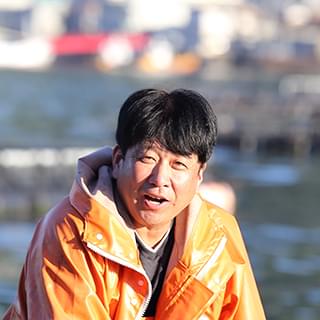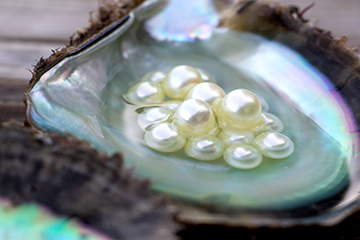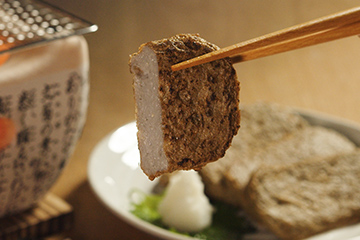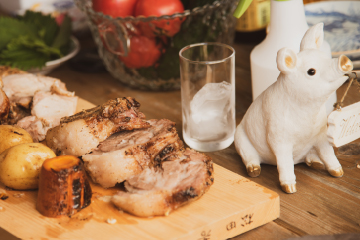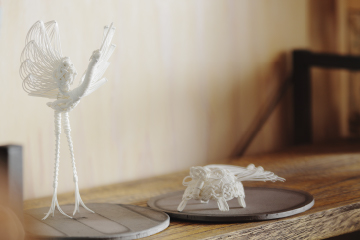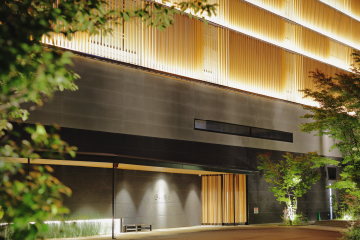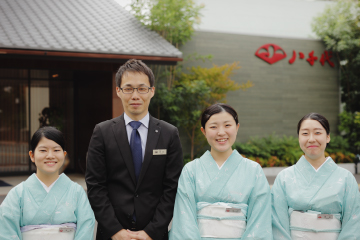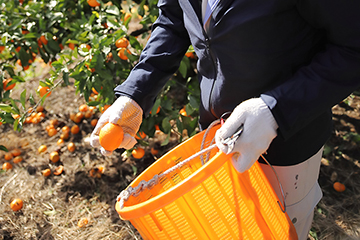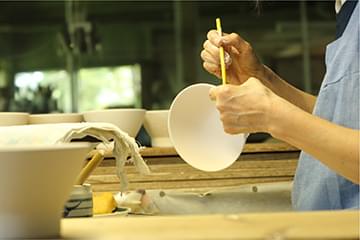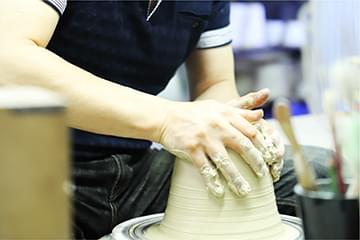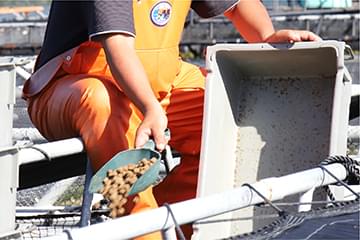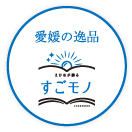As Appetites for Fish Fall, a Hero Rises— Fed On Ehime’s Local Specialty, “Mikan Fish” Take On Aquaculture At Large
The Uwa Sea is located in the Nanyo region, the southern part of Ehime Prefecture. Due to its deeply indented ria coast, the area is known as a national leading aquaculture site. In the inland areas, citrus fruits are widlely produced,including that of satsuma mandarin oranges. In the Uwa Sea, “Mikan Fish” is produced by combining Ehime’s local produce, “mikan” or mandarin oranges, with yellowtail and bream.
Mikan Fish mean fish that are raised with feed containing residue from orange processing. Mikan Bream and Mikan Yellowtail are well known. The fish’s dark red meat is less susceptible to browning, and the meat has less of a distinct fishy odor, so it is popular even with people who don’t usually like eating fish.
For this article, we visited Uwajima Project and Nakata Suisan to interview the people who developed Mikan Bream.

Increasing the Value of Farm-Raised Fish, Opening Up the Future of the Fishery Industry with the Power of IT
Uwajima Project is a company in Uwajima that processes fish and coordinates fish-related projects. Currently 54 domestic employees work on various projects in the hopes of forming a regional trading company. We interviewed Koji Saiki, a deputy manager of the administration department.
The development of Mikan Fish was initiated to solve problems in the agriculture, forestry and fishing industries. Mass disposal of the residue from orange juice production was an issue in Ehime Prefecture, and they were seeking effective ways to reuse it. According to a study, orange peels contain polyphenols that can be utilized for preventing the browning of fish—a solution to a problem in the fishing industry. The Ehime Research Institute of Agriculture, Forestry and Fisheries was conducting research on this.
It was found that browning can be prevented by feeding orange peels to fish for about two weeks. In addition, there was the unpredicted effect of adding an orange flavor to the fish.
At that time, the Ehime Research Institute of Agriculture, Forestry and Fisheries asked us to investigate if citrus-flavored fish would be accepted by consumers. We immediately experimented with about 15 fish in a fish pond. They were then offered to customers and our employees. Nearly 90% of them said, “Nobody will buy such a strange fish.” However, remaining 10% of them,mostly women and children said it was less fishy and easy to eat.
Saiki himself thinks that a fishy flavor is an tasty point of fish, so such an opinion (less fishy and easy to eat) was new to him.
We introduced the fish to various companies, saying, “We have an interesting fish.” A major revolving sushi restaurant showed interest and immediately ordered 7,000. We had raised 15 fish as samples, but there were many uncertainties for commercial cultivation in a fish preserve, including the rate of leftover feed and the required period to add flavor to the fish. The fish would definitely sell if the flavor was successfully added, yet there also was a risk. Under such circumstances, Nakata Suisan was the first to volunteer to do this.

Mikan Bream—a combination of bream (the prefectural fish of Ehime) and orange, the specialty product of Ehime. After its launch in April 2013, the fish became a long-selling item of the company. The citrus flavor accumulates in fatty parts, such as the belly.

Assorted sashimi of Mikan Bream. It appears the same as regular bream, yet the difference becomes obvious once it is eaten. A fresh orange scent passes through your nose for each bite, without leaving any fishiness in your mouth.

Offering Mikan Fish with the Hope that it will make fish more popular
Farm-raised fish are fed live food, which causes the fishy smell. For the Mikan Fish, the limonene in orange peels works as a deodorizer and masks the fishy smell. As a part of our activities to promote farm-raised fish, we welcome field trips by elementary schools. If there are no opportunities to eat good fish in childhood, then subsequent generations will naturally not eat fish. We believe that having children eat fish will boost fish consumption in Japan.
A common problem in the entire fishing industry is a shortage of successors. Uwajima Project actively carries out public relations campaigns, so that young people are interested in the job of fish cultivation.
Young people perhaps don’t even know about jobs in fish cultivation and fisheries. Fishery work is referred to as one of the 3D jobs (Dirty, Dangerous and Demeaning). However, like in our company, there are jobs for coordinating fish-related projects to accommodate requests from customers, including feed improvement and forming partnerships with the other companies’ plants, rather than doing physical work. We provide information through our blog in order to convey information about fish cultivation jobs.
Compared with wild-caught fish, farm-raised fish tend to give an impression of being unsafe and artificial. Saiki said he’d like to eradicate such an impression. We asked him about the hidden possibilities of farm-raised fish and the fishery industry.
In Japan, farm-raised fish are not highly valued compared with wild-caught fish. On the contrary, in Europe, farm-raised fish are highly valued, because they can be sustainably produced and are safe. Farm-raised fish are under human control with a known history, such as what they were fed and what type of cultivation environment was used.
Furthermore, today’s fishery industry is largely automated with IT, and I think it’s entering into an interesting phase. Soon, rearing young fish and feeding will be entirely manipulated, artificially controlling the cultivation environment. I believe this will lead to a stable fish production and supply while maintaining high quality, just like industrial products. The industry can be further developed by exerting intelligence and technology, I think.

Innovating Without Fearing Risks, Creating Smiles with Oranges and Fish
Nakata Suisan was the first to try raising Mikan Fish since the experimental phase. The company is also attempting to develop new fish, including strawberry bream and chocolate yellowtail. We interviewed the president of Nakata Suisan, Rikio Nakata—whose attractive, gentle smile mismatches his somewhat more wild overall appearance—about the decisions he has made as business manager and the challenges he has faced.
I never forget the shock of when I first ate a sample of Uwajima Project’s Mikan Fish—“My mouth is full of citrus flavor! I’ve never had such fish before!”
Many companies hesitated due to the risk of offering a new feed, but Nakata volunteered for the Mikan Fish development.
Nobody knew what would happen to the fish by adding orange to their feed. It might cause major damage if all the fish died. So all the companies vacillated over raising the Mikan Fish. I also considered the risks, but I thought, “If we are going to do this, it won’t be fun unless we are the first ones to start,” so I was the first one to raise my hand.
Today, the Mikan Yellowtail and Mikan Bream are mega hits. However, there have been various troubles along the way.
At first, we had a hard time because the fish didn’t eat much feed containing orange. We experimented with different orange varieties, including satsuma mandarin, Kawachi Bankan, amanatsu, and dekopon. Now, we mainly use iyokan, which adds the most flavor. We also tested the percentage of orange in the feed, and found that fish don’t eat it when the orange concentration is greater than 35%.
It was hard to maintain the flavor at a constant level. We heard complaints that the citrus flavor is less pronounced during winter, since fish only eat about five bowls. A few years ago, we began using “iyokan oil,” extracted from orange peels, during winter. This enabled us to obtain a constant flavor throughout the year.

By using the Shinkei-jime slaughter method, fish stay fresher. This method uses a wire to push out the nervous system. It delays rigor mortis, keeping the fish tastier and of better quality than the No-jime slaughtering method (which uses ice to kill the fish).

The first step of bream cultivation is purchasing young fish. They are kept in a fish preserve for 2–2.5 years and grow to weigh 1.8–2 kg. Oranges are given during the final three months, since they are high in vitamins and nutrients but don’t produce meaty fish.

Further Development of Fish with a Desire to Raise the Best Fish
Currently we sell 200,000 regular bream and 100,000 Mikan Bream. We aim to increase Mikan Bream shipments to around 150,000. For this, we need to make people aware of how tasty Mikan Bream is and increase the number of regular customers.
Nakata is tireless in his desire to move forward after Mikan Bream, and is constantly working on developing new fish, such as strawberry bream and chocolate yellowtail. He desires to begin expanding overseas in the future and deliver tasty fish to more people.
We currently ship to Hong Kong and are going to start shipping to Dubai. We would like to continue to develop tasty and mind-blowing fish that stimulate the appetites of younger generations, and will expand our product line with higher brand-value fish like Mikan Bream.

Koji Saiki of Uwajima Project and Rikio Nakata of Nakata Suisan both desire for more people to enjoy tasty fish, although from different standpoints.
Saiki says, “We aim to improve the quality of farm-raised fish and to further increase its value using the power of IT.” Nakata says, “We always desire to raise the best fish. We’d like to develop fish that consumers like and find tasty.” They do not only try to sell fish for their own companies, but rather, they try to show gratitude to the sea where they raised the fish and to their local community. We can see they are trying to give back to the aquaculture industry.
In the near future, we expect to see Mikan Fish acting as a trigger for Uwajima’s farm-raised fish to be distributed all over Japan, and the rest of the world.
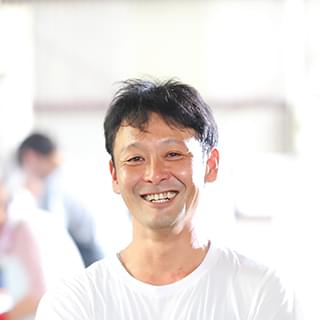
TEL:+81-89-528-0180
http://www.project-u.jp/index.cgi
https://twitter.com/uwajima_project
https://www.instagram.com/uwajima_project/
https://www.facebook.com/uwajima.project.sabakijyoshi
